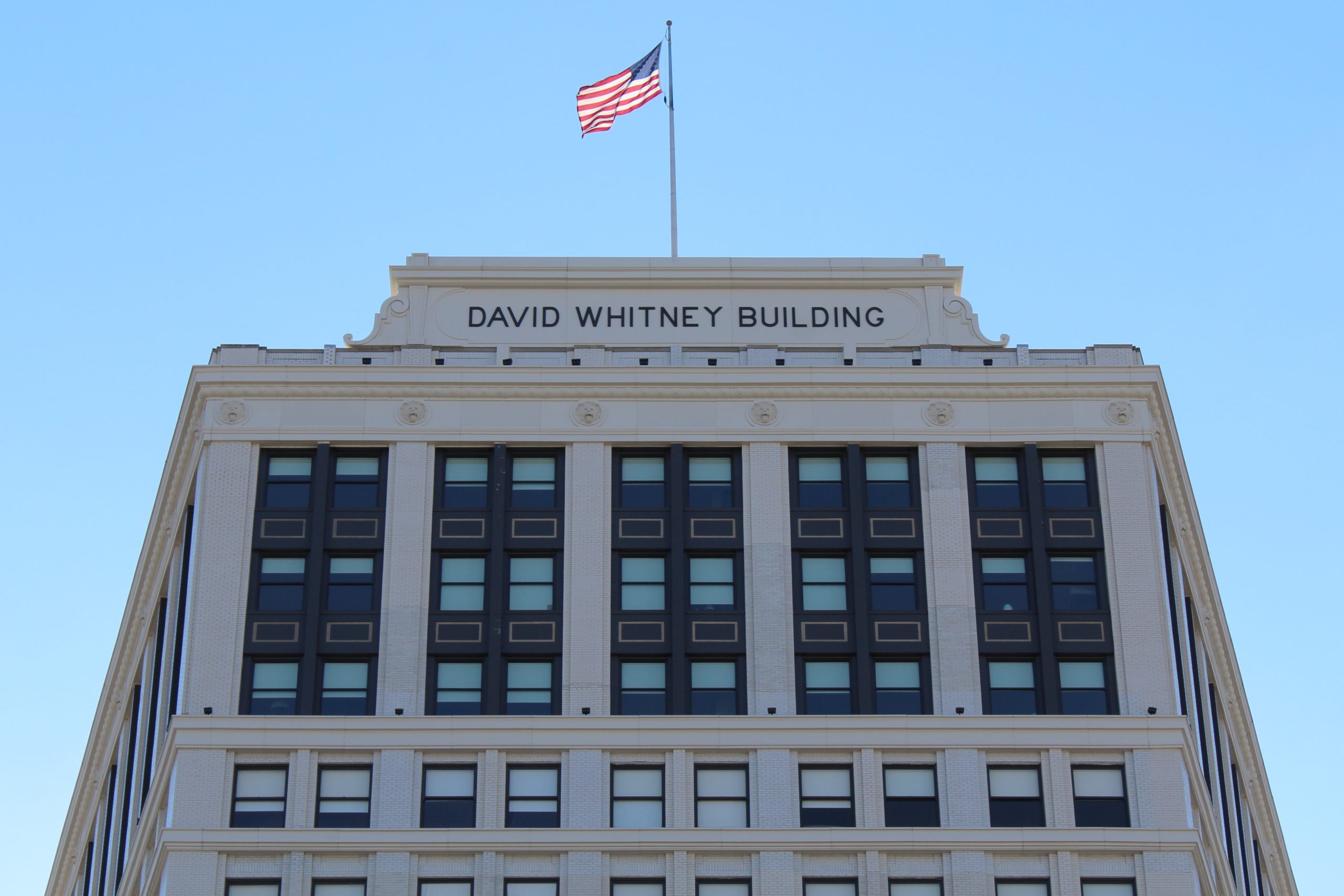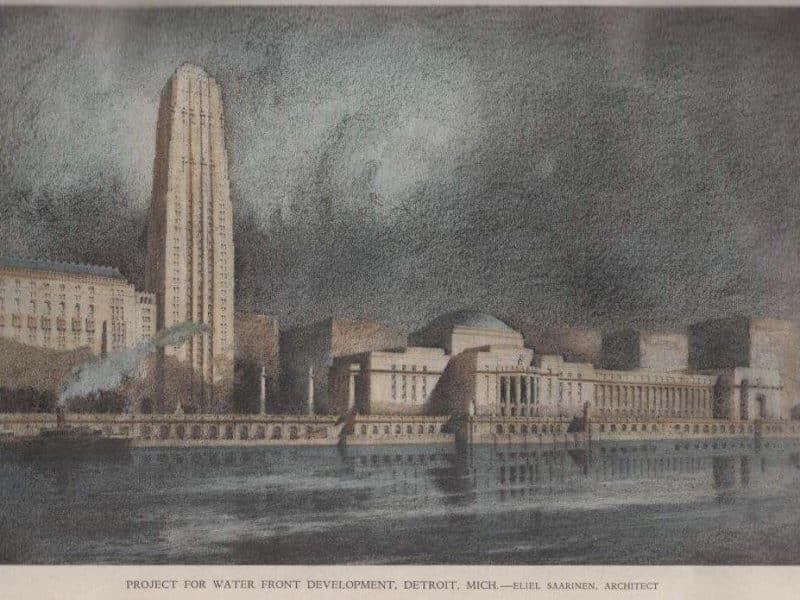The versatile material and company that’s restoring Detroit’s downtown architecture
Glassline recreates lost or deteriorated architectural elements for historic buildings that are undergoing rehabilitation. And they're making them all out of fiberglass.
Since its opening in 1964, Guy Kenny’s Plymouth-based industrial company Glassline has specialized almost exclusively in the fabrication of corrosion-resistant fiberglass equipment for the steel, chemical, and automotive industries. Hence the massive, multi-chambered tank that’s currently under construction in the middle of his workshop.
“The principle,” Kenny tells me matter-of-factly, “is that is they can put a car in there, give it seven years of exposure in four or five weeks, and see how it holds up. They’ll raise the temperature inside from 40 degrees below zero to 140 at one degree a minute. They’ll spray it with water and salt. They can even make it snow in there.”
Fascinating as the tank is, it is not actually the reason for my visit to Glassline. I’m there to learn about the curious variety of disembodied architectural elements that are strewn about Kenny’s workshop, and that give it the appearance of a disassembled classical theatre set. There are elaborately carved lions’ heads, bits of balustrade, and several sections of cornice — the ornate ledges that crown historic buildings and are intended to deflect rainwater from their facades.
That’s because, in the last ten years, Kenny has brought his technical know-how to a whole new market: the revitalization of downtown Detroit. In addition to their industrial work, Glassline has taken to recreating lost or deteriorated architectural elements for a host of historic buildings that are undergoing rehabilitation. And they’re making them all out of fiberglass.
The steady return of the rich and varied details that grace downtown Detroit’s historic buildings is a happy development in an otherwise long and tragic story. In June of 1958, 79-year old Myrtle Taggart was killed by an almost literal ton of bricks that fell off a crumbling, seventh story cornice. This incident prompted the city to swiftly pass an ordinance to fine building owners whose cornices were not properly maintained. As a result of this edict, and the widespread economic decline of subsequent decades, cornices often proved too costly to keep up and were removed en masse.
Thus the preponderance of historic buildings in Detroit that seem somehow incomplete, scarred by mysterious bands of metal or brick where iconic cornices once proudly jutted.
Beginning with the 2006 resurrection of the Book Cadillac Hotel, however, downtown cornices, along with a host of other lost architectural details, began making an unprecedented, investment-fueled comeback. Back then, Kenny, who had recently fabricated replacement elements for historic buildings in both Flint and Bay City, won a bid to recreate the Book Cadillac’s 23rd floor water table (essentially a cornice that’s positioned lower on the building). He figures that in the ten years since, his work in architectural fabrication for the downtown market has grown to account for anywhere between 30 to 40% of his business. Recent projects include work on the refurbished David Whitney Building, Broderick Tower, Gabriel Richard Building, Detroit Savings Bank, Capital Park Lofts, the Vinton Building, and the Lofts of Merchants Row.
The Glassline team typically starts by scaling each building and making a silicone mold of the remaining features on site. The molds are then brought back to the Plymouth workshop, where they are cast in fiberglass, or glass fiber reinforced plastic (GFRP) in industry parlance. When installed, the new fiberglass elements blend seamlessly with the historic materials that surround them, usually stone or terracotta.
I ask Kenny why architects elect to use GFRP at all. Why not use original materials? “Terracotta is clay. And it cracks,” he says. “Water gets into the cracks, freezes and thaws, expands and contracts, over and over again.” The water, meanwhile, creeps into the building’s structural supports, corroding them over time. Fiberglass, however, doesn’t move. It also weighs significantly less, can be installed in large panels, and is both durable and comparatively inexpensive.
Sarah Rabe, architectural designer for Kraemer Design Group and project architect behind the 2013-14 revitalization of the David Whitney Building, echoes Kenny’s sentiment. And while they don’t always use fiberglass for historic reconstruction, she’s enthusiastic about the material’s versatility, adding, “GFRP can be formed into almost anything you can imagine.”
That’s one of the reasons she hired Glassline to recreate the David Whitney’s cornice (complete with faux joint lines that mimic the originals), decorative lions’ heads, and its intricate pediment sign, which was made in three pieces and installed with a crane. Since Glassline is a local company, Rabe adds, “the project team was able to frequently collaborate on the final design in person, which was a huge benefit.”
Back in Glassline’s Plymouth workshop, Kenny and I are close to finishing our conversation when he shows me a final, show-stopping sight: the shrink-wrapped remains of a 10 foot tall terracotta sculpture. “The Maiden,” as Kenny calls her, is one of 12 caryatids — columns sculpted in the shape of nude female figures — that have supported the 14th floor cornice of the Book Building since 1917. Renovation of the Book Building and adjacent Book Tower has just begun, and Glassline is responsible for fixing up these remarkable maidens, whose heads alone weigh 400 pounds each. They’ve been in bad shape for decades — missing pieces were replaced at various times with now-rotting wood. Kenny’s team will be laying their maiden out in the workshop, making the silicone mold there, and eventually recreating her, piece by piece, in fiberglass.
As he shows me the bundled up caryatid, Kenny notes how the workers who removed her speak of her with reverence. “They are considerate of the fact that she’s a piece of art,” he says.
When I ask about his own apparent reverence for downtown’s historic buildings and the myriad details that adorn them, he answers with a smile, “Well, like a lot of people, I’m sort of a frustrated, wannabe architect.”
But the art of architecture is, as ever, a profoundly collaborative one, and Detroit is lucky to have Guy Kenny on the downtown team. By design, the things he makes blend in; if they’re not hiding in plain sight, then they’re not working. But take a walk through the reinvigorated central business district on any given day, look up, and you’ll see his work all around you.
Matthew Piper is a writer and photographer covering art, architecture, and culture in Detroit. Follow him on Twitter at @matthewsaurus and on Instagram at @matthewjpiper.
All photographs by Matthew Piper.













